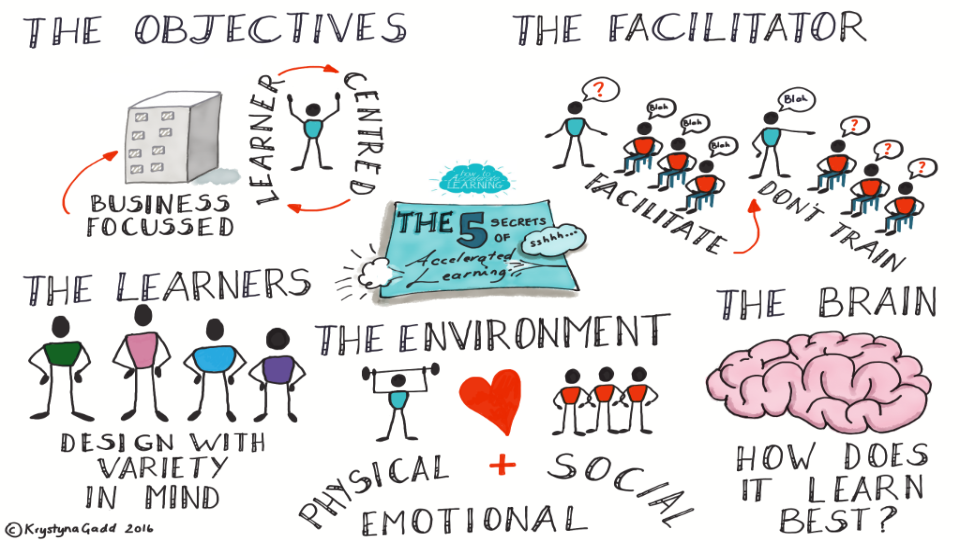Last time we explained why you should facilitate, not train, and explored the importance of allowing learning to happen.
If we are predictable and use the same methods of learning delivery time after time, how will we encourage curiosity? How will we keep their attention?
In this article we will be looking at how we should also inject variety into our learning solutions, given the variety of different learners that exist. This helps to engage the learners and keep them on track.
We are way past tailoring learning to peoples’ learning styles, as many sources have already proven this not to be effective. What we can do, however, is repurpose the learning styles and other models in order to inject that all-important variety into learning.
Why is variety in learning important?
According to Stella Collins, curiosity and attention are important components of learning. “We all benefit from learning through rich multisensory environments,” she says.
Curiosity has the effect of increasing dopamine levels in our bloodstream, which in turns keeps us engaged. If we are predictable and use the same methods of learning delivery time after time, how will we encourage curiosity? How will we keep their attention?
“Attention can be provoked by internal or external stimuli,” according to Stella Collins.
Imagine you are on a train and lost in your thoughts when suddenly another train whooshes by and disturbs your attention. In the same way, we should be ensuring that when we deliver learning, we grab the learner’s attention.
Will we be able to grab it in the same way every time and in a relaxed way so that they can learn?
We can use something familiar to ‘associate’ the learning and help learners to make connections in their minds.
In the 2018 CIPD factsheet, Jan Hills wrote: “something like 70% of everything we do, including our job, is habit, so you will not create new habits by going on a one or a two-day programme. That takes a much longer period of time. What this is telling us is that learning needs to be more of a process so that we embed those new habits over a period of time, so people adopt the new behaviour”.
Bearing this in mind, we have to move away from the notion that all learning should be done on a training course, and instead look at how we can make the process varied and interesting, so that it gives people enough time to make the changes necessary.
My series of short videos for the Learning and Performance Institute on 100 ways to learn will give you lots of ideas on how to mix things up and create variety. Let’s now look at how we can repurpose some theories to inject the variety needed in our learning design and delivery.

Lex McKee’s memory principles
In his book, The Accelerated Trainer, Lex McKee outlines five key principles for making things memorable. This video explains these principles in more detail:
These principles are:
- A is for association
We can use something familiar to ‘associate’ the learning and help learners to make connections in their minds. In the video above you can see that we’ve used the five vowel sounds to help you remember the five key principles. Pictures are a great way to do this – creating symbols, which readily associate with what you are talking about may help. Examples: use pictures (hippopotamus for hypotenuse in maths), associate the parts of a car with the human body, etc.
- E is for emphasis
Adding emphasis supercharges the recall process. Bringing in an object to symbolise what you need to do/learn/change will add emphasis. Pausing and posing a challenging question about what you are presenting on, will also add emphasis. An inspiring quote may also help in this area. Examples: get volunteers to act out the activity or theory, or use a rugby scrum style activity.
- I is for imagination
Whenever we capture someone’s imagination, we have embedded a concept in his or her memory. To empower our participants to be able to recall the learning, we must allow them to stimulate their own imaginations. Imagination is more powerful than willpower. Stories and pictures help to stimulate imagination. Examples: Create a story for a theory or topic, inspirational quotations, poster.
- O is for order
Anything that is presented in a logical sequence is far easier to recall. This is because we can follow the chain of associations, link by link. Pay attention to the order you present things and create a flow. Examples: Get everyone to order themselves physically in a process, or parts of a formula, mnemonics.
- U is for unusual
Anything unusual sticks in the mind and can assist recall. Orchestrating something unusual in the first or last few minutes of your presentation experience can ensure that the key points stick forever. Getting the audience to participate in an activity around the subject may stick in their minds. Examples: mime something in a similar way to Pictionary, larger than life characters in a story etc.
Howard Gardener’s multiple intelligences theory
Howard Gardener’s theory of multiple intelligences gives us even more variety to can keep our learners engaged. This video offers some ideas on the huge variety of ways to learn.
Sharon Bowman’s six trumps
Sharon Bowman’s book, Brain Science To Make Training Stick, offers lots of ideas for how to implement what she calls ‘six learning principles that trump traditional teaching’. More explanation of this is offered in this video:
You may also find this visual representation of the ‘six trumps’ useful.

In the next article I’ll be looking at the fourth secret of accelerated learning, which is all about the environment. This is not just about the physical environment (because these secrets apply to all learning), but also considers the social and emotional environments too.











